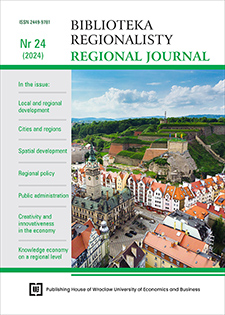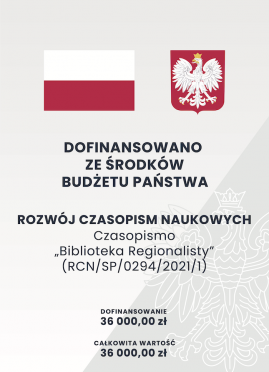NEMO Creativity Station – social innovation for communes
DOI:
https://doi.org/10.15611/br.2024.1.07Keywords:
local development, social innovation, creativity, partnership of science and businessAbstract
Aim: The term ‘social innovation’ is increasingly used in the context of social challenges, as well as economic and spatial ones. The synergy effect between the social, economic, and technological dimensions of innovation is recognised by academic communities, as well as by entrepreneurs and local government representatives. This study aims to identify, characterise, evaluate, and prioritise the determinants of implementing the outcomes of the project “NEMO Creativity Station – A Social Innovation for Communes”.
Methodology: The subject of the research is a socially innovative service dedicated to stakeholders of the local public space in Polish communes, promoting a morally and physically healthy lifestyle. The study primarily employs a descriptive method, case study analysis, and benchmarking solutions implemented in European countries.
Results: The article presents the results of an analysis of the impact of the “NEMO Creativity Station” project on the social, economic, and technological development of Polish communes. It highlights that implementing this public infrastructure model can improve residents’ quality of life, promote a healthy lifestyle, and increase the attractiveness of communes for investors and inhabitants. Moreover, the research findings emphasise the importance of social innovation as a catalyst for positive change in local governments.
Implications and recommendations: The analysis highlights the necessity of implementing innovative models of public space management based on cross-sector partnerships and participatory planning. In particular, the study recommends the broad involvement of stakeholders (local governments, businesses, universities, and local communities) and the utilisation of financial support instruments, including EU funds, to ensure the effective implementation of the NEMO project.
Originality/value: The study can be used in the debate on the importance of social innovation in the management of local government units. The NEMO project is presented as an innovative solution integrating education, recreation, and social development, making it unique in the context of local development policy. The article highlights a research gap regarding the impact of such initiatives on the long-term development of communes, which adds value for academic communities and public decision-makers.
Downloads
References
Adelman, J. (2008). The rise of Israel. Taylor & Francis.
Beckman, T., Aslam, H. i Shaw, E. (2023). Understanding the social innovation trap: Fragmentation and the call for integrated research. Journal of Social Innovation Studies, 45(1), 75-94.
Blanchet, T. (2024). The role of social innovation and cross-sector collaboration in addressing wicked problems. Innovation: The European Journal of Social Science Research, 37(1), 1-3. https://doi.org/10.1080/13511610.2024.2326864
Ciumasu, I. M. (2024). Eco-cities. Scenarios for innovation and sustainability. Springer.
Empirium-Group. (2015). Wewnętrzne materiały źródłowe przedsiębiorstwa. Wrocław.
European Commission. (2011). Creative Europe – A new framework programme for the cultural and creative sectors (20142020). https://www.eumonitor.eu/9353000/1/j9vvik7m1c3gyxp/viuqti49qlzu
Florida, R. (2002). The rise of the creative class, and how it's transforming work, leisure, community and everyday life. Basic Books.
Florida, R. (2005). Cities and the creative class. Routledge.
Florida, R. (2008). Who’s your city. How the creative economy is making where to live the most important decision of your life. Basic Books.
Goldsmith, S. (2010). Power of social innovation – how civic entrepreneurs ignite community networks for good. John Wiley & Sons.
Komisja Europejska. (2020). Europa 2020 – Strategia na rzecz inteligentnego i zrównoważonego rozwoju sprzyjającego włączeniu społecznemu. KOM(2010) 2020 wersja ostateczna. https://ec.europa.eu/eu2020/pdf/1_PL_ACT_part1_v1.pdf
Landry, C. (2000). The creative city. A toolkit urban innovators. Earthscan.
Low, E. L. i Tay, E. G. (2021). Singapore math and science education innovation. Springer.
Merrill, M. Y., Burkhardt-Holm, P., Chang, C. -H., Islam, MD. S. i Chang, Y. (2019). Education and sustainability: Paradigms, policies and practices in Asia. Taylor & Francis. https://doi.org/10.4324/9781315109992
Ministerstwo Infrastruktury i Rozwoju. (2014). Zasady realizacji instrumentu Rozwój lokalny kierowany przez społeczność w Polsce. https://www.gov.pl/attachment/8adf0cab-c923-4851-94ce-804e2bb827f1
Miszczak, K. (2010). Strategic Policy Intelligence tools in management of European regions. The Journal of Regional Development and Planning, 2(2), 199-204.
Miszczak, K. (2012). Dylematy rozwoju regionu ekonomicznego w świetle wyzwań XXI wieku. Wydawnictwo Uniwersytetu Ekonomicznego we Wrocławiu.
Nexus Nowe Technologie SA. (2015). Wewnętrzne materiały źródłowe przedsiębiorstwa. Wrocław.
Nicholls, A. i Murdock, A. (2011). Social Innovation. Palgrave Macmillan.
Pasi, S. i Howard, G. (2021). Finnish lessons 3.0: What can the world learn from educational change in Finland? Teachers College Press.
Phills Jr., J. A., Deiglmeier, K. i Miller, D. T. (2008). Rediscovering social innovation. Stanford Social Innovation Review, 6(4), 34-43. https://doi.org/10.48558/GBJY-GJ47
Purvis, B., Mao, Y. i Robinson, D. (2019). Three pillars of sustainability: In search of conceptual origins. Sustainability Science, 14(3), 681-695. https://doi.org/10.1007/s11625-018-0627-5
Roco, N. M. (2024). Social innovation, social enterprises and the cultural economy: Cultural and artistic social enterprises in practice. Routledge.
Rogers, P. P., Jalal, K. F. i Boyd, J. A. (2008). An introduction to sustainable development. Earthscan. European Union/The Young Foundation. (2010). Study on social innovation. A paper prepared by the Social Innovation eXchange (SIX) and the Young Foundation for the Bureau of European Policy Advisors. https://www.slideshare.net/goodpaper/studyon-social-innovation
Szymańska, D., Korolko, M., Grzelak-Kostulska, E. i Lewandowska-Czuła, A. (2016). Ekoinnowacje w miastach. Wydawnictwo Naukowe Uniwersytetu Mikołaja Kopernika.
Toivonen, T. (2012). Japan’s emerging youth policy: Getting young adults back to work. Routledge.
Tübke, A., Ducatel, K., Gavigan, J. P. i Moncada-Paternò-Castello, P. (Eds.). (2001). Strategic policy intelligence: Current trends, the state of play and perspectives. IPTS Technical Report Series. https://forschungsnetzwerk.ams.at/dam/jcr:69757c74f7b5-4c32-be89-95d63e9dc5ed/2001_foresight_eur20137en.pdf
Vaishnavi, V. K. (2024). Social innovation design cases. A chronicle of global journeys. Taylor & Francis. Akademicki Wrocław. (2016). dr Katarzyna Miszczak - Nexus Nowe Technologie SA: Przystanek kreatywności NEMO – innowacja społeczna dla gmin. https://wca.wroc.pl/dr-katarzyna-miszczak-nexus-nowe-technologie-sa-przystanek-kreatywnosci-nemo-innowacja-spoleczna-dla-gmin
Wyrwa, J. (2015). Innowacje społeczne w teorii i praktyce. Polskie Wydawnictwo Ekonomiczne.
Zaleski, J. i Szlachta, J. (2008). Benchmarking regionalnej polityki naukowej i innowacyjnej. Szkoła Główna Handlowa w Warszawie.
Downloads
Published
Issue
Section
License
Copyright (c) 2025 Katarzyna Miszczak

This work is licensed under a Creative Commons Attribution-ShareAlike 4.0 International License.
Accepted 2024-11-24
Published 2025-01-31







